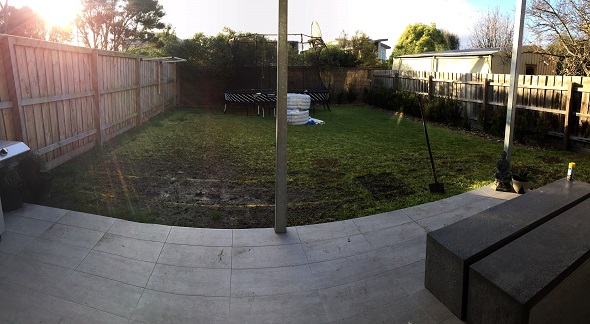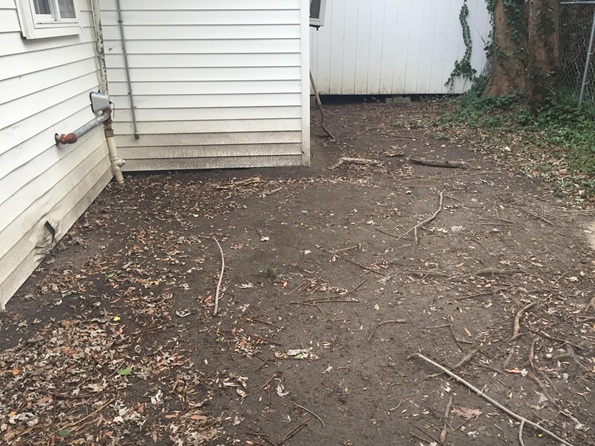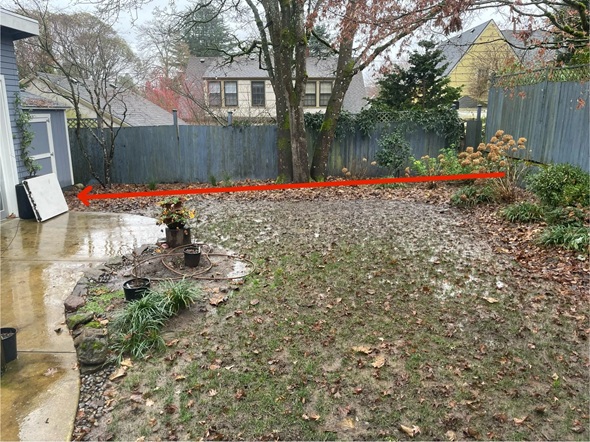Unless you have a perfect flat yard with a full, lush lawn and great drainage. There is a chance that after some rain, you might have a muddy yard. It’s not the end of the world, we want to give you some great ideas for how to dry a muddy yard.
What causes a muddy yard?
The main cause of a muddy yard is usually really poor drainage. It’s easy enough to identify the next time it rains, go outside, and take a look at where water is pooling in your yard. Also, where is the water coming out of the downspouts running to?
If water pools in your yard, the downspout water runoff is running back into your yard. Then it is most likely going to cause a muddy area in your yard.

Fixing the Downspout runoff
Most roofs have gutters and downspouts for catching and directing water to either drainage or far enough away from your house to not cause a problem.
If you have identified downspouts as the problem, start by making sure that the end of the downspout is extended at least 6 feet away from your foundation.
If it’s not, it’s a really easy process to extend. Most downspouts will be PVC plastic or a tin; take a trip to your local hardware store.
Buy a joiner and some downspout pipe lengths, and join them together, and extend the length.
That way, you can direct the downspout toward a ditch, a pond, a garden, or another lower-lying area outside the lawn.
Just make sure that the drainage area is clear of debris or vegetation so the runoff is not impeded in any way.
Fixing an uneven yard
If it’s simply water pooling after rain that is causing a muddy yard, then it’s the slope of your yard that is the problem.
It’s as simple as a lawn that’s level or slightly lower in the middle is going to collect water.
To give water the chance to run off away from your house and yard, you need a lawn that slopes at a 2 percent rate away from your house.
That way, gravity makes rainwater flow away from your house in whatever direction it’s sloping.
To fix the grade issue, you need to regrade your lawn. You have a couple of options here: getting more topsail bought in and spread properly.
Or taking topsoil from the bottom of your yard to the top side.

Lawn maintenance to dry a muddy yard
Sometimes it’s the soil not able to absorb water. This is generally due to lawn thatching. Lawn thatching is a layer of dead grass, root sand debris that forms between the grass and the soil surface.
This is where a garden tiller is really handy for aerating your lawn. By doing it once a year, a garden tiller will dig small holes into the ground to loosen compacted soil.
It lets the air in to the root system as well as drainage for water. We’d recommend tilling the soil to at least 6 inches.
Fertilizer and organics
If you have gone to the trouble of retiling your lawn, make sure you add fertilizer and spread fresh lawn seeds onto it.
You want to get the most out of the tilling as well as give your lawn the added boost of fertilising.
Adding more drainage
Where you can add topsoil, or aerate your lawn, then installing a fringe drain in a trench may be the next best thing.
A trench is simple. Grab a shovel and start to dig a trench the length of where you want to drain water from, and in the direction of where you want to drain it to.
With a trench, if you want it to be permanent, then think about lining it.
Simple concrete with a grate works pretty well.
A French drain is a trench lined with landscape fabric, something like a perforated drain pipe. Then filled in partially with gravel and covered with soil and reseeded.
French drains are perfect in most yards, and the location is usually undetectable after plants grow.
Getting in a professional to dry a muddy yard
If you are still stuck with how to dry up a muddy yard, then maybe its time to get in a professional landscaper.
Professional landscapers have the tools and experience to fix any yard issue you might be facing.
They can do the big jobs like removing the grass and regrading and reseeding or relaying another lawn.
Adding hard landscaping
Sometimes, no matter what you do, you will not escape muddy spots in your yard. You can add a new hardscaping feature to your yard.
Depending on where the muddy area is, you can build a hard material path between the two areas. A concrete or concrete boardwalk will keep your feet dry.
If you have a muddy area beside your house, think about adding a patio to it. Even a gazebo or paved lounge area.

Pets in your yard
Even if you have a yard with perfect drainage and a well-aerated lawn. It’s pointless if the family pet is out there digging holes.
Hardscaping is usually the best answer to a dog that loves to dig in one area.
You can pave around the area, then surround it with large touch-salt-tolerant plants.
Create a feature garden
If you’ve tried the above, and are still struggling, then maybe it’s time to consider embracing the wet area. You can create a water garden feature in your yard.
It’s a practical solution to deal with a muddy yard. You can convert the area into a water garden full of water-tolerant plants.
Any downspout water runoff can be directed into the water garden.
Just make sure that the area you are going to convert is at least 10 feet away from your house.
When we were young, it was fun to get out there and play in the mud.
As we get older and want to enjoy living out back, it’s not fun looking and walking in the mud. With a little bit of effort and imagination, you can dry a muddy and pretty easily.
How to dry a muddy yard might be a combination of a few different the, but whether it’s soil amendments and regrading your yard.
Adding additional landscaping or creating a feature water garden, then you can have a mud-free yard within in week

